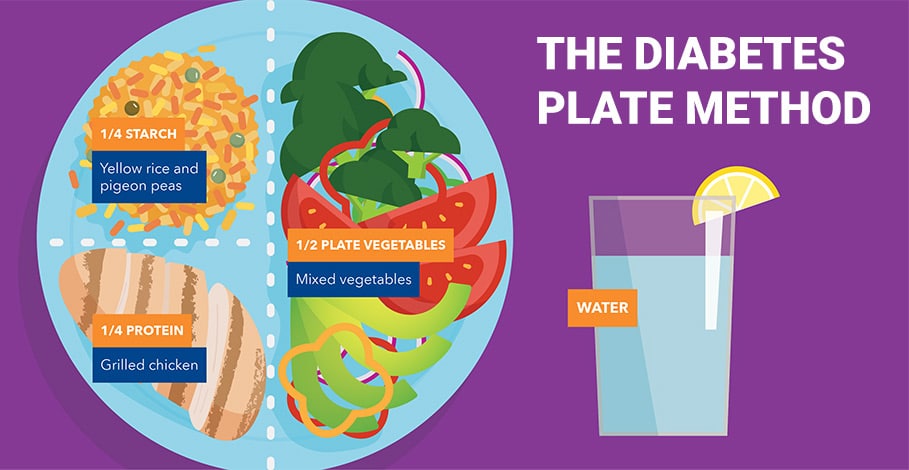If you have diabetes, your blood sugar is either too high or too low. That’s why managing your disease with the right diet and healthy habits are important. Eating balanced meals and snacks is a great way to control your blood sugar while enjoying the foods you love.
The Diabetes Plate Method is an easy way to visualize exactly what a healthy meal looks like when you’re living with diabetes.
Once you understand how different foods affect your blood sugar, you can modify your diet so that it’s perfectly in control at all times.
Managing your blood glucose levels will help prevent complications from developing down the road. Understanding how different foods affect your blood sugar is key to managing your diet successfully.
Here are some tips on how to eat well if you have diabetes using the diabetes plate method as a guide for healthy eating habits that will improve your blood sugar control.
What is the Diabetes Plate Method?
The diabetes plate method is a simple, easy-to-follow visual guide for healthy eating habits. The method allows you to balance your plate with a combination of vegetables, healthy fats, proteins, and complex carbohydrates.
In the 1980s, Swedish dietitians developed the diabetes plate method to help people with diabetes eat better.
Ideally, you should aim for about 45-60 grams of carbohydrates at each meal. That may sound like a lot, but there are plenty of ways to do it without having a boring diet.
The diabetes plate method will make sure you’re eating the right amount of carbohydrates at each meal.
Carbohydrates are an important source of energy, but they can also raise blood sugar. So, you need to eat the right amount to stabilize your blood sugar. The diabetes plate method will help you do this.
The method also encourages people with diabetes to eat more vegetables. This is important because vegetables are low in calories and rich in vitamins and minerals. A healthy diet should include plenty of vegetables.
The Basics of the Diabetes Plate Method
The diabetes plate method is a visual approach to healthy eating. Those with Type II diabetes mostly use it, but people with Type I diabetes can also benefit from it.
There are eight sections on the plate: six for different food groups and two for beverages.
The six sections on the plate represent the six nutrients that affect blood glucose levels the most. These are carbohydrates, protein, fats, fiber, fluids, vitamins and minerals.
The two sections on the plate represent snacks and dessert. The diabetes plate method shows you how different amounts of each nutrient affect your blood glucose levels.
The plate method is especially helpful for people who are new to diabetes and want to learn the basics of blood glucose management. It’s also great for people who have been living with diabetes for a long time and need a refresher on meal planning.
Which Food Goes Where?
As we discussed in the basics of the diabetes plate method, you need to balance your plate with a combination of vegetables, proteins, fats, and complex carbohydrates.
Your vegetables should take up half the plate, with protein making up about a quarter and your carbohydrates filling the rest of your plate.
This might seem like a lot of vegetables, but they’re an important part of a healthy diet. Your plate should include a mix of different vegetables, both starchy and non-starchy.
Starchy vegetables are higher in carbohydrates, so you want to eat them in small amounts. Starchy vegetables include corn, peas, potatoes, and yams.
Non-starchy vegetables include broccoli, cauliflower, lettuce, and carrots.
You can choose to mix starchy and non-starchy vegetables, or you can choose all non-starchy vegetables. Either way, your plate should mostly include vegetables.
How Do You Make A Diabetic Plate?
To use the diabetes plate method, you must first learn how to make a diabetic plate. To do that, you must first decide how many calories you need per day. Once you know that, you can pick the right amount of servings for each part of the plate.
We suggest you make a diabetic plate with the following breakdown:
1. One-third Vegetables
Vegetables are packed with vitamins, minerals, and antioxidants. They’re great for managing diabetes because they don’t raise blood sugar levels. You can either eat them raw or steam them for maximum nutrients.
2. One-third Carbs
Carbohydrates are mainly found in rice, grains, potatoes, and beans. While carbs don’t help people with diabetes, you shouldn’t avoid them either. You can avoid problems by ensuring you’re not eating too many carbs.
3. One-third Proteins
Proteins can be found in meat, fish, and beans. They’re extremely important for people with diabetes because they help you maintain muscle mass and prevent muscle degeneration.
4. One-third Fats
Fats can be found in nuts, seeds, oils, and butter. People with diabetes often avoid fats, but that’s a bad idea because they’re necessary for a healthy body. Dairy can be either milk or yogurt. It’s best to avoid dairy if you have diabetes because it can cause blood sugar issues.
The last part of your plate should include dairy or a side dish with wildcard food.
A wildcard can be any extra food you want to include in the meal. It’s usually something you like or brings a different flavor to the plate. For example, you could add an orange to your plate since oranges are rich in vitamins and minerals.
Once you understand the method, you can modify your diet so that it’s perfectly in control at all times.
How to Get Started: The Implementation
The full plate is divided into five sections:
- 30 grams of protein,
- 15 grams of fiber,
- unlimited vegetables,
- 50 grams of healthy fats, and
- one serving of fruit.
You can adjust the amount of each section depending on your meal and your blood sugar management goals.
1) 30 grams of protein in one meal
The protein section of the diabetes plate method is about 30 grams. A full meal should have about 30 grams of protein to keep your blood glucose levels under control.
If you have a smaller meal, you can add some protein in the form of a protein shake or some nuts.
Getting your 30 grams of protein in one meal will help you stay in control of your blood glucose levels.
The amount of protein your body takes in should be balanced by the amount of glucose stored as glycogen in your body.
If there is too much protein in your body, it will be turned into glucose. If there is not enough protein in your body, your glucose levels will rise.
That’s why it’s so important to get the right amount of protein in one meal to avoid blood sugar spikes.
2) 15 grams of fiber in one meal
The carbohydrates section of the diabetes plate method is about 45 to 55 grams. But within that, you should try to add 15 grams of fiber.
Fiber is important because it helps slow down how quickly your body absorbs the carbohydrates in your meal.
When you add fiber to your meals, you’ll feel fuller for longer and also reduce your blood sugar levels.
3) Unlimited vegetables – at least 2 cups per meal
The vegetable section of the diabetes plate method is unlimited, and you should eat at least 2 cups per meal.
Vegetables have a very low impact on blood sugar levels, so eat as many of them as you’d like.
The fiber in vegetables also helps keep your blood sugar levels low, so make sure to include them in every meal.
4) 50 grams of healthy fats per meal
The fats section of the diabetes plate method is about 50 grams. Fats are important for your body but can affect your blood glucose levels.
Fats should be healthy, and you should choose polyunsaturated or monounsaturated fats whenever possible.
Fats are often paired with carbohydrates, so you’ll want to make sure to get them in a meal where the rest of the carbs are healthy.
5) 250 mg or less of sodium per meal
The sodium section of the diabetes plate method is about 250 mg or less for each meal.
Sodium is a natural part of our diets, but too much of it can raise blood glucose levels.
You’ll want to keep sodium levels low, so aim to keep it under 250 mg per meal.
If you’re eating a meal with high sodium content, make sure to pair it with a low-sodium vegetable.
6) One serving of fruit per day – either first thing in the morning or as a snack.
The fruit section of the diabetes plate method is one serving per day, either first thing in the morning or as a snack.
Fruit is full of vitamins and nutrients that are essential for a healthy diet. Fruit can actually help lower your blood sugar levels, so it’s a great addition to any meal.
Fruit also has a low impact on blood sugar levels, so you don’t have to worry about eating it with your meals.
Examples of Healthy Meals
In order to make sure your meals are balanced and healthy, here are some examples of diabetic-friendly meals that would fit each section of the plate.
- Cereal with Yogurt and Fresh Fruit: 30 grams of protein (from the cereal), 15 grams of fiber (from the fruit), and no more than 100 calories
- Tuna Salad Sandwich: 30 grams of protein (from the tuna) and no more than 100 calories
- Apple and Walnut Salad: lots of veggies, 50 grams of healthy fats (from the walnuts), and no more than 100 calories
What Are The Benefits of The Diabetes Plate Method?
The diabetes plate method can help you eat healthier, lose weight, and reduce your risk of diabetes complications. Let’s talk about each benefit in more detail.
1. Healthier Eating
The diabetes plate method helps you make healthier food choices. You’re more aware of the food you’re eating, and how many calories, fats, proteins, and carbs are in each dish. This awareness leads to better eating habits and more nutritious meals.
2. Fewer Cravings
If you have diabetes, you probably experience cravings for sugary and carb-heavy foods. The diabetes plate method can help you reduce cravings by putting you in control of what’s on your plate. Once you know what you’re eating, cravings usually go away.
3. Reduced Risk of Diabetes Complications
A healthy diet can reduce the risk of diabetes complications. A healthy diet for people with diabetes includes lots of fruits, vegetables, and high-protein foods such as beans and nuts. It also includes low amounts of dairy, eggs, fish, and whole grains.
The diabetes plate method is a great way to get all the nutrients you need in each meal. Using the diabetes plate method makes you more likely to eat healthier and reduce your risk of complications.
Bottom Line
The diabetes plate method is a visual guide that helps you understand how different foods affect your blood glucose levels. The plate has five main sections, each representing a different set of foods.
The carbohydrates and proteins are represented on the plate because they’re the two main meal components.
Fiber and fats are also included on the plate as healthy additions that help balance out your meal.
The plate also has a section for vegetables and fruit – both of which have a low impact on blood glucose levels.
The carbohydrates section also has a “fiber section” within it.
It would be best if you tried to get 15 grams of fiber in one meal whenever possible. The protein section is about 30 grams, the carbohydrates section is about 45 to 55 grams, and the fats section is about 50 grams.
You should try to keep sodium levels low, and one serving of fruit per day will help lower your blood sugar levels.
Endless combinations of healthy meals, such as the above, will help you manage your blood sugar levels with the diabetes plate method.






